Belfountain Under Siege
A dispatch from the battlefield.
It’s no exaggeration that my village of Belfountain in Caledon is under siege. At its annual general meeting in May, the Belfountain Community Organization updated residents about the latest developments in its traffic battle, the sewage-treatment-plant skirmish, the too-many-tourists conflict, the Manors-of-Belfountain-subdivision clash, and a pair of aggregate-mining struggles. Tucked in at the bottom of the night’s agenda, which also included the sticky issue of fundraising – it’s not going well – was “Christmas Potluck.” This lone community-building activity garnered a scant five minutes in the two-hour-plus meeting. It reminded me of a wartime bulletin broadcast by the venerable BBC at the height of the Blitz.
The experience also brought to mind a seasoned municipal politician who once told me he became a councillor because he wanted to do great things for his community. Once elected, however, he discovered he spent most of his time preventing his fellow politicians, bureaucrats and others from doing stupid things. He had little energy left over to accomplish all the good he’d expected to do.
And isn’t that how life feels sometimes?
Rather than kicking up our heels attending Christmas potlucks, we spend our time writing letters, posting signs and adding our names to petitions to stop a quarry or a super highway or a sewage plant or a housing development. And during these Covid-19 days, we talk of little else than the stupid things politicians are doing.
I can’t imagine the pressure government officials and regulatory agencies must be under at any time, much less during this pandemic. So I try to give them the benefit of the doubt – much to the chagrin of my partner, Alex, who is less forgiving of stupidity than I am. But when it comes to the devastating acts and misguided deeds that are eroding life in my precious childhood home in Belfountain, generosity eludes me.
I sometimes reminisce with my siblings about those carefree summer days of our youth, living a kilometre west of Belfountain’s pair of general stores. Good as Caledon was in the 1960s, much is better today. In places, our forests have matured. I’m more apt to see deer and foxes when I’m out walking on an expanded network of trails. And I love stopping in for a great coffee in our village café where I’ll likely run into friends and neighbours. In other words, Belfountain remains a vibrant community, though it’s increasingly under stress.
Most of the village’s 300 residents live in modest houses with private, often-unreliable wells and temperamental septic systems. With two cafés where villagers can meet for coffee, three stores, a trio of ice cream parlours, a church, a beautiful conservation area, one stop sign and no fire hydrants, Belfountain lies at the west end of the scenic Forks of the Credit Road. Fields and forests wrap around our village, making it charming to residents and visitors alike. Belfountain, you might say, has charisma.
But because it is situated in the Town of Caledon, Belfountain is included in the Region of Peel, along with the cities of Mississauga and Brampton. As a result, the town has access to resources and services that can make other local municipalities swoon. However, this setup also means Caledon is part of the Greater Toronto Area, making it subject to a unique, ill-fitting set of urban rules and polices that are undermining its rural nature and community spirit. Given a provincial mandate for Caledon to more than quadruple its population to 300,000 over the next three decades, the Belfountain Community Organization’s battles will only escalate.
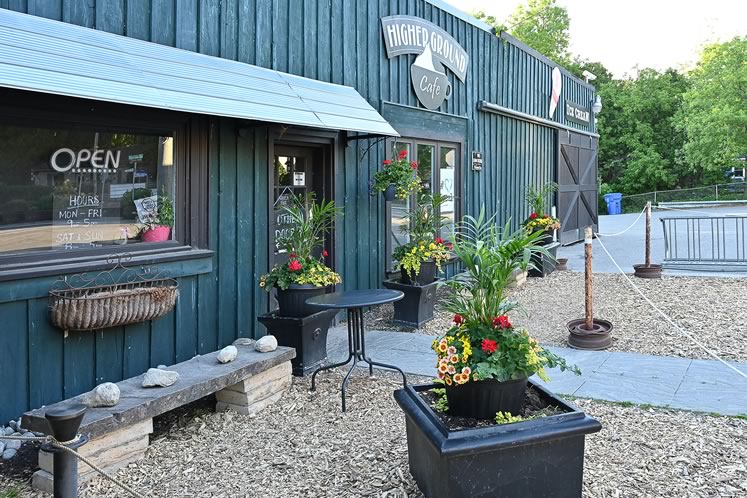
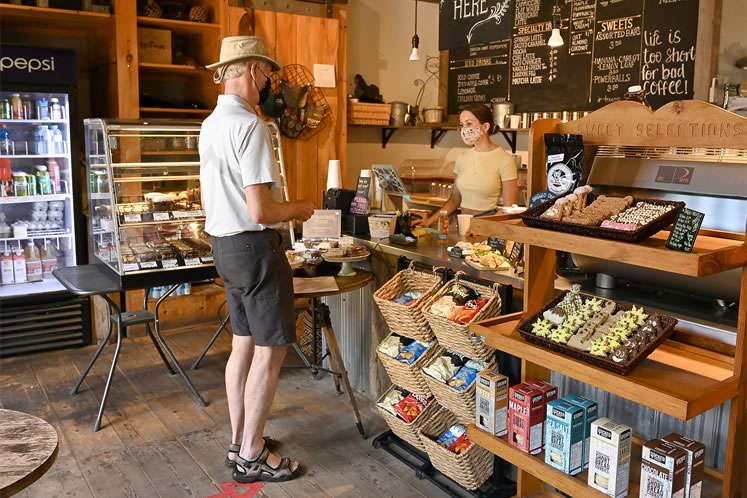
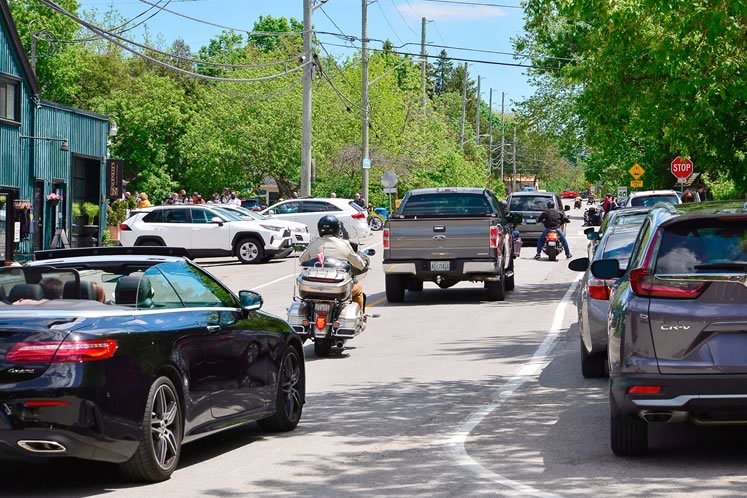
Scenes from a village Life in Belfountain is a complicated tapestry of indisputable charms and worrisome challenges. Photo by Fred Webster.
When I was young, my dad worried Caledon would eventually be subsumed by the city. I grew up expecting that one day I’d flee Caledon, just as some of my neighbours are refugees from Meadowvale and other villages now completely engulfed by Mississauga or Brampton. With passage of the Niagara Escarpment Plan, designation of the Niagara Escarpment UNESCO Biosphere Reserve, opening of the Bruce Trail, public acquisition of an almost uninterrupted swath of protected land stretching from Belfountain to north of the Forks of the Credit Provincial Park, and creation of Ontario’s Greenbelt, I began to believe Belfountain might be spared the unkindlier effects of the urban itch to grow. After all, the village is buffered by layers of protective legislation and contained within a huge stretch of greenspace.
But I can no longer ignore my eyes, ears and heart. And it’s not just the effect of the pandemic, though Covid-19 has made the future arrive a bit sooner. Despite my hopes, Belfountain is being relentlessly squeezed by government policies that jam ever more people into the GTA, and demand that GTA municipalities provide the housing, water, sewage, aggregate, highways and other resources required by this increasingly dense congestion of humanity. No matter if it means polluting pristine rivers, digging up and paving over ever more prime agricultural or highly protected, ecologically significant land, and compromising our already insufficient supply of recreational space.
Some days I feel as though Belfountain is James Bond’s seductive love interest in a 007 movie – a sort of village fatale. In my imagined film, our hamlet becomes trapped in one of those chambers where the walls are slowly closing in. Operating the controls are crooked overlords in cahoots with a cast of money-lusting Goldfingers. They want us down on our knees, repeating over and over again the mantra, “Grow or Die. Grow or Die. Grow or Die.” – hoping to make us accept that paving over and digging up our environs is good for the economy and therefore good for Belfountain. They want us to believe that loud racing vehicles careening down our valleys and tourist litter are just the price we must pay for living in a beautiful place.
Meanwhile, from stage left, enters our hero, or in this case, our heroes: the Niagara Escarpment Commission, the Local Planning Appeal Tribunal and Credit Valley Conservation – the champions of our fish and wildlife, our hills, valleys, water, peace and quiet. In the film, these regulatory agencies wrench the levers from the overlords, but in real life it’s seldom that simple.
We want to believe these agencies will rescue the environment and our community – in fact, they might think they can. Their seemingly heroic intervention may cause the walls to slow down, briefly stop or even recede for a while. But the squeeze never lets up. The walls inch ever closer. James Bond is not coming to the rescue. We, the villagers and a few committed politicians, are left to our own devices. And while the foe appears to be a developer or multinational aggregate company, the battle is really against governments whose policies mean aggregate extraction trumps the environment and agriculture, and whose rules pit small communities against giants and call it fair game.
My film plot might sound overly dramatic, but Belfountain really is being battered from all sides. In the past, when I told people I lived there, their faces would light up. They would say, “You are so lucky. It’s so beautiful.” Now a frown crowds out their smiles and they add, “But it’s awfully busy, isn’t it?”
Don’t get me wrong – I repeat, “Belfountain is a great place to live.” But lately my neighbours and I find ourselves hoping it will be cold and rainy on the weekends. Otherwise the throngs will descend, taking over our coffee shops, crowding out the Belfountain Conservation Area, overwhelming our rural roads with rush-hour-like traffic jams, and filling our valleys with the lingering roar of motorcycles and racing cars. When I was young, we only had heavy traffic in Belfountain once a year on Thanksgiving weekend.
It’s not that I begrudge anyone getting out to enjoy the countryside (I make my living writing hiking guides!). But surely the goal is to enjoy the sights and smells and peace of nature – all of which is lost when eager crowds turn our village into a midway and our rural roads into thoroughfares. Belfountain’s new reality means that despite as many as ten OPP officers patrolling the main street and surrounding roads, even setting up a satellite office in our community hall, car racing, littering, blocked driveways and illegal parking make village life – to put it mildly – challenging.
If an oversupply of visitors was Belfountain’s only concern or even its major woe, other busy towns might not feel much sympathy. But too many tourists is only one of the closing walls that our able, but overworked BCO is battling.
We also have to contend with the prospect of 7.2 million litres per day of Erin’s heated sewage effluent being dumped into the West Credit River upstream from our village and next to temperature-sensitive brook trout spawning beds. Then there’s our limited access to and development of what was once our community’s treasured conservation area. Reservations are now needed if, for instance, we want to take our dogs there for an evening stroll.
There are two expanded gravel pits nearby and a new application for a large quarry that involves blasting below the water table. The renewed hunt for aggregate is fuelled, I’m told, by the resurrected plan to build Highway 413 that will cross south Caledon. And we will soon have to endure the flattening of Mississauga Road, which connects commuters to their jobs in Brampton, Mississauga and Toronto – as if we need another raceway.
Along with all that, there are plans for two car-dependent housing developments on our doorstep. One will help triple the population of our neighbouring village of Erin to almost 15,000, the majority of them commuters. The other, for 75 homes on the southern border of Belfountain, is the latest in a series of on and off development proposals that villagers have so far successfully opposed for 25 years. Bad projects, it seems, never completely go away. It’s only a question of time before we expect to see a new application to mine the Rockfort Quarry – the original pit application on the site was quashed in 2011 after an exhausting 13-year battle.
Finally, there’s the issue of aesthetics and local governments. They seem to think faux-vintage streetlights, suburban rolled curbs and suburban-style entrance “installations” like those recently erected in nearby Alton, are what a “quaint” village should look like. I cringe when I imagine how this schlock appears to visitors from Europe or Britain. All this plus, I’ll say it again, the guttural roar of Harleys, the screaming whine of crotch-rocket motorbikes and the screeching acceleration of racing cars.
I grew up on a 90-acre farm at the corner of the Belfountain-to-Erin Road and the 6th Line, as we used to refer to Bush Street and Winston Churchill Boulevard. At the end of a long, potholed driveway, we lived in an old stone house, kept horses and a few chickens in the bank barn and went for daily summertime swims in the West Credit River where it flowed below our house. We hunted for salamanders and built forts in the hayloft. We walked to the Belfountain Public School, filled our car at Trimble’s Garage (now the wonderful Higher Ground Café) and bought many of our groceries from one or the other of two general stores. My parents tried hard, but the chaos of five unruly children, an ever-evolving pack of dogs, power outages and an unreliable supply of water meant our family life was more Dan Needles’ “Fence Posts” column in this magazine than TV’s old Lifestyles of the Rich and Famous.
Just north of Belfountain, on the Fifth Line (Shaw’s Creek Road) beside the Elora-Cataract Trailway (formerly a Credit Valley rail line), there’s an elegant old stone house. Not so long ago, it was a farm worked by the Pinkney family. I once bought an old galvanized-steel water trough from the Pinkneys. They charged me “two bits,” delivery included. Today, the house is boarded up, the barn has been torn down and no outbuildings have been left standing. There isn’t even any gravel, as the Pinkneys, who built the house in 1886 and lived there for generations, made a better living farming a wayside gravel pit than hay. Standing between this old farmstead and demolition by the aggregate company that now owns it as well as a massive expanse of aggregate-rich land all around it, is David Kendall, a local villager. Recognizing the historic value of the house, he successfully lobbied to save this piece of Caledon’s past.
Sadly, no one protected a handful of other heritage farms around Belfountain. They have been completely razed. There aren’t even any crumbling foundations or telltale lilacs to hint at the stories of those who once lived there. Their farms have been obliterated – flattened into gravel-pits-in-waiting, or to make way for yet another housing development. I try not to imagine how it would feel if my childhood home were similarly violated and our past wiped clean.
At the BCO’s AGM, I learned that while Kendall won the first round in his battle to save the Pinkney house, his ability to win the war is far from assured. Cracks have opened in the house’s foundation, boards have been ripped from its windows and fissures have appeared in its beautiful fieldstone walls. Curious kids, moisture and the absence of a family to call the place home are slowly eroding the historic building despite it now being protected under the Ontario Heritage Act, and Kendall’s ongoing negotiations with the aggregate company that still owns it.
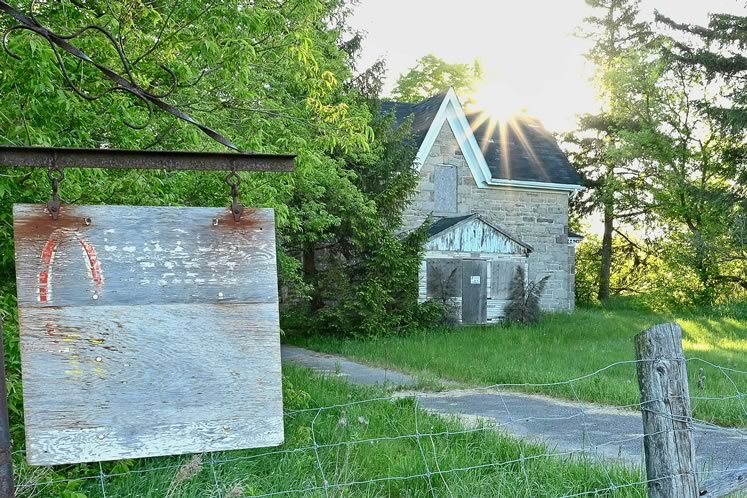
The Pinkney century farm. Photo by Fred Webster.
In the dystopian version of my movie, the walls closing in on Belfountain do eventually stop. At first glance, the village that emerges bears little resemblance to the Pinkney house. Most residents have succumbed to generous offers from a numbered company. This corporation tarted up their homes into smart shops that sell “authentic” Ontario kitsch made in China. Delighted tourists from all over the GTA and beyond stroll under faux-vintage streetlights, side-stepping parked cars and gleaming motorcycles that have rolled over the rolled-over curbs, as they admire endless parades of antique cars. They remark to each other, “Belfountain is so quaint.”
But if you peek behind the façade, you’ll see that like the cold, empty rooms behind the boarded windows of the Pinkney house, the new Belfountain is also suffering from having no family. The handful of people who still live there have never visited the Belfountain Conservation Area. The BCO has faded away. There are no battles being waged. The Manors of Belfountain has swollen from 75 suburban homes to three times that number. Gravel has been excavated to the brink of the river valley. And there is no talk, not even for five minutes, about a Christmas potluck.
Dystopian films are popular right now, but it’s my movie and I want a different, more inspiring future for Belfountain. Trouble is, 007 hasn’t given me a plausible way to win our cold war – why would he? That would put him out of a job. So how to triumph when Belfountain’s woe, the drive for economic growth, is so powerful and pervasive? Which brings me back to the Pinkney house.
What Belfountain needs is an imaginative village-wide version of Kendall’s win-win-win solution for the Pinkney house. He recognizes it’s both a losing battle and a distraction to pursue stop-gap measures with town staff and the aggregate company over cracking foundations and vandalized windows. Kendall says his ward is being “demolished by neglect.” Instead, he has proposed that in return for a charitable receipt, the aggregate company donate the house and an acre that surrounds it (on land almost entirely bereft of gravel) to the Headwaters Health Care Centre. Kendall says he will finance, interest-free, the restoration of the house so its kitchen and halls can once again come alive with the laughter of people who call it home. He then explains that the hospital can sell the property, pocketing a tidy profit.
This creative idea may yet save the fine old stone house. But while we can put a celebratory martini, shaken, not stirred, in Kendall’s hand, he’s not 007 and Belfountain’s plethora of battles won’t be solved by a single generous benefactor. It is being demolished by attrition – attrition resulting from having to fight so many individual battles on so many different fronts.
In the movie Goldfinger, 007 asks, “Do you expect me to talk?” To which Auric Goldfinger replies, “No, Mr. Bond, I expect you to die.”
No one, not even the overlords, wants this fate for Belfountain. They aren’t intentionally trying to quash the village’s heart and soul. But that’s what could happen unless we come up with a holistic solution that turns things around so it’s those soul-destroying battle plans that can be relegated to the last five minutes – or less – of a two-hour agenda. And wouldn’t that be a kick-up-your-heels, Christmas potluck kind of community-building good idea!
Related Stories

Conservation Authorities v. Doug Ford
Mar 31, 2021 | | EnvironmentThe provincial government is stripping Ontario’s conservation authorities of the very meaning of their name – and key protections for the environment.
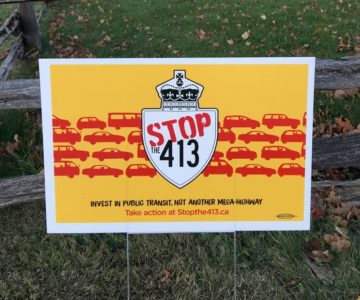
Highway 413: The Opposition Reloads
Nov 24, 2020 | | EnvironmentThe Ford government has resurrected the controversial highway that will cut through south Caledon. Is it a done deal?
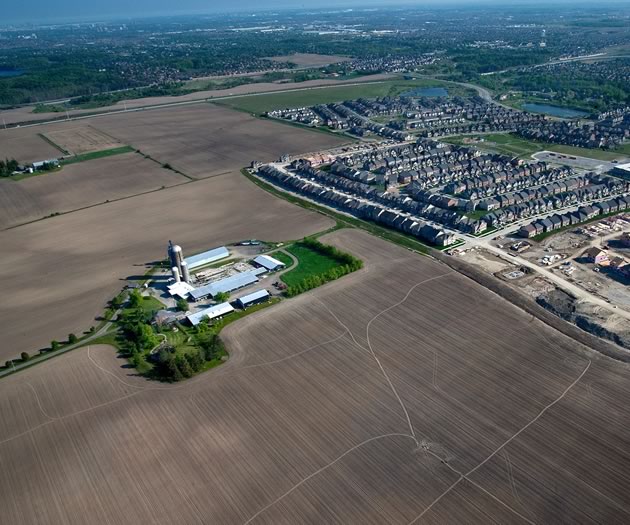
10 Years of the Greenbelt
Jun 16, 2015 | | EnvironmentOntario launched the Greenbelt Plan’s 10-year review, which is taking place concurrently with reviews of the Niagara Escarpment Plan, the Oak Ridges Moraine Conservation Plan & Places to Grow.
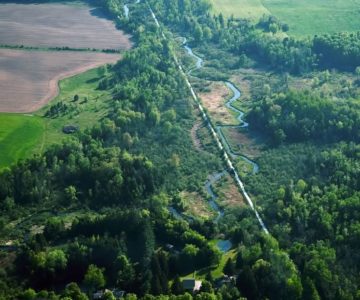
Finding Balance in Caledon: The Urban/Rural Divide
Jun 16, 2015 | | EnvironmentIn less than two decades Caledon’s population will be 75 per cent urban. Can its countryside values survive the shift?
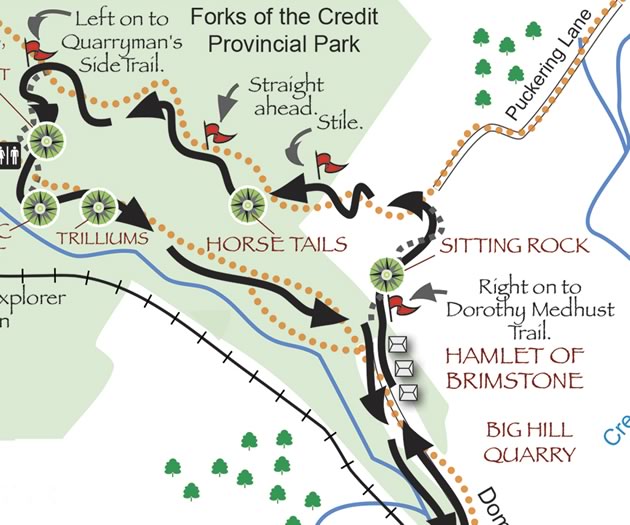
Caledon Hikes
Jun 16, 2015 | | LeisureNicola Ross shows readers how to navigate local Caledon trails, including the Bruce Trail and the Trans Canada Trail, without having to backtrack or arrange to leave a car at a hike’s endpoint.

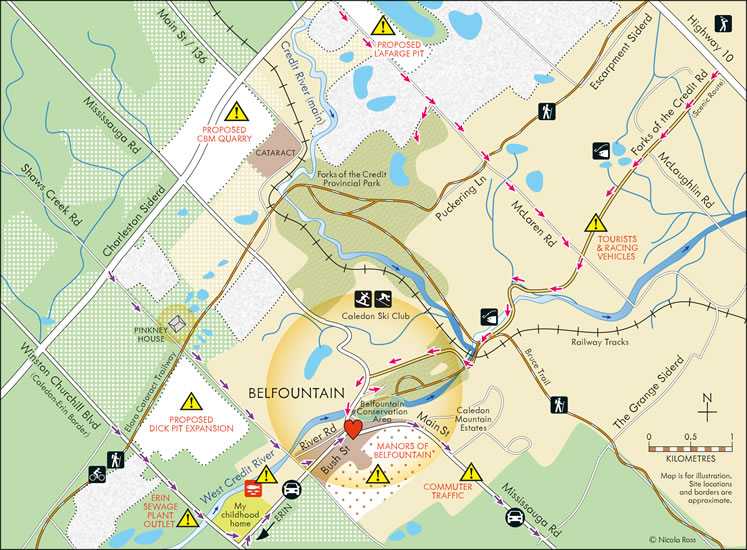





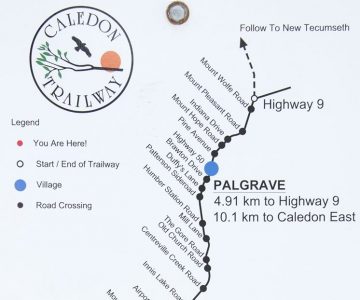






Good luck with slowing or stoping this, my advice is take the money and run.
Morley Brown
Mulmur
Morley Brown from Mulmur on Jun 27, 2021 at 3:56 am |
Harkening back to days long passed and looking at every possible change in the makeup of Belfountain as a negative and an assault on the residents is unfortunate.
As a long-time resident, if we are to help manage growth, it can’t exclusively be viewed as negative and an assault. An inability to look at how to take advantage of growth opportunities to the possible benefit of all residents and not just those that have grown up in Belfountain will only exacerbate issues.
I live in Caledon Mountain Estates, as does Mr. Kendall. Imagine the development proposed today. I suspect it would also be viewed as an “assault” on our town with inappropriate growth from outside. Being proactive, establishing constructive dialogue, and understanding that growth in some form is inevitable can be beneficial to Belfountain in creating a diverse and thriving community we all strive to create.
Jeff Turner from Belfountain on Jun 26, 2021 at 2:23 pm |
This is a terrific piece on one of the many rural communities within the shadow of the GTHA. I live in Niagara on the Lake and development and weekend traffic pose similar challenges. It must be twenty five years since I wandered the trails near Belfountain. Such a beautiful place.
Patrick Wilson from Niagara on the Lake on Jun 25, 2021 at 12:02 pm |
Oh Nicola, thank you for allowing us this eye opening look through your lens. I wish the rest of the world would treasure your Village as you do. There are many things more precious than gold and aggregates. As an Erinite I have no desire to be a part of your problem but it seems I have no choice. Is there any hope to turn this around?
Deborah Shortill on Jun 24, 2021 at 10:36 pm |
Funny, I was just up in Belfountain today for lunch at Higher Ground. While I don’t live in Belfountain I spend a lot of time close by up at the Caledon Ski Club in the winter time and years past hiking Forks of the Credit Provincial Park. Sadly I don’t do that much any more because it’s too busy. Call it the BlogTO effect, over toursim from day trippers is hitting all the pretty areas within easy driving distance of the GTA.
The more insidious threat however are the gravel pits which surprises me they are allowed to exist considering Caledon is part of the GTA Greenbelt along with luxury developments like The Manors of Belfountain, anyone buying into that are going to be in for rude awakening when they find out the water table is tapped out. I think the twin threats of agregate extraction and these thin wedges of luxury suburban developments are the result of a “Lets make a quick buck and screw the future” mindset that anyone reading this knows is not sustainable and will ruin the landscape and natural heritage we all hold dear.
Bill Smith from Oakville On. on Jun 24, 2021 at 9:59 pm |
Thank you Nicola Ross for so brilliantly capturing the situation in Belfountain and so eloquently depicting this beautiful hamlet . One of the solutions might be to advocate for Hard Urban Boundaries, like what has been accomplished in Waterloo Region with Countryside Line. The Auditor General has a report coming out this fall that may debunk the actual Growth Numbers which would negate the so called “need” for all this sprawl on protected countryside. A Provincial government that doesn’t insist on speculating 30 years into the future benefitting private interests would help slow the onslaught. Aggregate policies and municipal zoning that ban strip mining near communities, respect and acknowledge impacts to private wells banning extraction below the water table would also ease the stressors. Not to mention cancelling Highway 413 and the Bradford bypass. Within the village proper the noise bylaw is not enforced, and there are no traffic cameras. There are solutions that could help mitigate the chaos, but we need politicians willing to do the work and speak up for us. Thank you again for this excellent article.
Jenni from Belfountain on Jun 24, 2021 at 9:35 am |